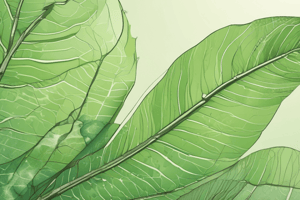Podcast
Questions and Answers
Petals are typically green, leaf-like structures that protect the flower bud.
Petals are typically green, leaf-like structures that protect the flower bud.
False (B)
Sepals function to attract pollinators to facilitate pollination.
Sepals function to attract pollinators to facilitate pollination.
False (B)
The anther is the part of the stamen that supports the filament.
The anther is the part of the stamen that supports the filament.
False (B)
The stigma is the part of the pistil that contains ovules (egg cells).
The stigma is the part of the pistil that contains ovules (egg cells).
The receptacle functions to produce pollen containing male gametes.
The receptacle functions to produce pollen containing male gametes.
Flashcards are hidden until you start studying
Study Notes
Petals
- Colorful, often fragrant, and delicate structures that attract pollinators
- Function:
- Attract pollinators (bees, butterflies, hummingbirds) to facilitate pollination
- Protect the reproductive organs of the flower
- May have ultraviolet patterns to guide pollinators to the nectar
Sepals
- Typically green, leaf-like structures that protect the flower bud
- Function:
- Protect the flower bud from damage and desiccation
- May be modified to attract pollinators or aid in seed dispersal
Stamen
- Male reproductive organs of the flower
- Consist of:
- Anther: produces pollen
- Filament: supports the anther
- Function:
- Produce pollen containing male gametes (sperm cells)
- Facilitate pollination by transferring pollen to the pistil
Pistil
- Female reproductive organ of the flower
- Consist of:
- Stigma: receives pollen
- Style: connects the stigma to the ovary
- Ovary: contains ovules (egg cells)
- Function:
- Receives pollen during pollination
- Facilitates fertilization by allowing sperm cells to reach the ovules
- Develops into a fruit or seed pod after fertilization
Receptacle
- The base of the flower that supports the other floral organs
- Function:
- Attaches the flower to the stem
- Provides a platform for the arrangement of the floral organs
- May store nutrients and water for the flower
Flower Structures
- Petals:
- Attract pollinators with color, fragrance, and delicacy
- Protect reproductive organs
- May have UV patterns to guide pollinators to nectar
Protection and Support
- Sepals:
- Protect the flower bud from damage and desiccation
- Can be modified to attract pollinators or aid in seed dispersal
Male Reproductive Organs
- Stamen:
- Consist of anther (produces pollen) and filament (supports anther)
- Produce pollen containing male gametes (sperm cells)
- Facilitate pollination by transferring pollen to the pistil
Female Reproductive Organs
- Pistil:
- Consist of stigma (receives pollen), style (connects stigma to ovary), and ovary (contains ovules/egg cells)
- Receive pollen during pollination
- Facilitate fertilization by allowing sperm cells to reach ovules
- Develop into a fruit or seed pod after fertilization
Flower Base
- Receptacle:
- Attaches the flower to the stem
- Provides a platform for arranging floral organs
- May store nutrients and water for the flower
Studying That Suits You
Use AI to generate personalized quizzes and flashcards to suit your learning preferences.




